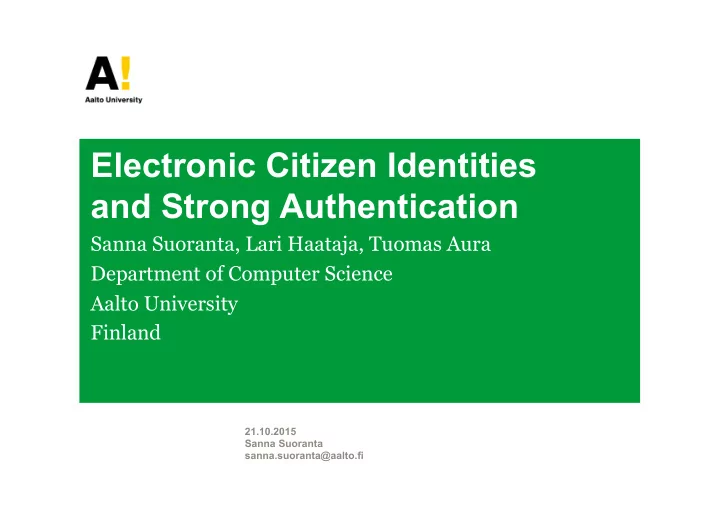

Electronic Citizen Identities and Strong Authentication Sanna Suoranta, Lari Haataja, Tuomas Aura Department of Computer Science Aalto University Finland 21.10.2015 Sanna Suoranta sanna.suoranta@aalto.fi
Content • Motivation • Situation around the world • Technical solutions • Usage around the world • Summary 21.10.2015
Motivation Why is strong citizen authentication interesting? • OECD claim: lack of mature digital identities delays the development of Internet economy – But credit cards are widely used as payment methods without strong citizen authentication • Citizen id used for bootstrapping of other identities • Nordic countries as early adopters – Finland was the first country with smart cards for strong citizen authentication (1999), but few people use it – Estonia provides “electronic id” to anyone and waits this to boost its economic life Why the survey? • Background survey for our more technical research 21.10.2015
Overview National eID projects Picture from http://www.nxp.com/documents/leaflet/939775017234_V9.pdf 21.10.2015
Strong Citizen Authentication Two approaches: • A governmental organization as identity provider – Traditional source of identity (birth certificate -> passport) – Often used both offline and online • Outsourced to trusted non-governmental identity providers – E.g. banks, post offices, mobile phone operators – Already required to verify the customer identity strongly, e.g. “know your customer” rules for banks 21.10.2015
Authentication by Smart Cards • Electronic identity cards with a micro chip – Contains e.g. X.509 certificates and biometric information – Targeted for both online and offline use – Contactless and contact cards • Bank cards may also be used in authentication if the bank is the identity provider – Banks may also provide card readers to their customers • Pros: considered to be uncopyable and tamperproof • Cons: requires chip reader or NFC capability • Deployed (or soon to be deployed) in many countries: – Argentina, Australia, Austria, Belgium, Brazil, China, Estonia, Finland, France, Germany, Indonesia, Italy, Japan, Mexico, Portugal, Russia, South Africa, Spain, Switzerland, Turkey etc 21.10.2015
Password Authentication • Some countries use passwords as the authentication method – May be combined with another method – Pros: familiar and “easy” to use – Cons: may be weak, prone to phishing – Canada, India, New Zealand, South Korea, Saudi Arabia • Some banks offer citizen authentication using one-time- passwords – Delivered e.g. on paper – Pros: banks are considered to be trustworthy – Cons: the same credentials used for online bank login, your money at risk – Denmark, Finland, Sweden, Lithuania 21.10.2015
Authentication with Mobile Phone • Typically as a part of two-method authentication – One-time code sent to the mobile phone – New Zealand • ETSI Mobile Certificate – Cryptographic keys stored on the SIM card – Used for authentication and digital signatures – Australia, Finland, Estonia, Lithuania, Netherlands, Norway, Poland, Slovenia Switzerland, and Turkey • Pros: trusted communication channel, personal device • Cons: mobile malware, currently on national level, lack of trust between operators internationally 21.10.2015
Other Physical Tokens for Authentication • USB stick – Switzerland (post office as identity provider) • Pros: most of the computers have the USB port • Cons: cannot be connected to mobile phones 21.10.2015
Usage around the World • Estimated that 33% of world’s population have an electronic identity card in 2009 – Highest numbers in Estonia: 90% has the card, 24% voted online in 2011 parliament election – e.g. in Spain 27% has the card, but only 2% has card reader and 5% have used the card • Mostly still used offline • Some countries do not have or have even abandoned their online citizen authentication projects – Fear of central database of sensitive information – Citizens trust private companies more than the government – E.g. United Kingdom, USA 21.10.2015
Summary • Many citizen authentication projects are still early deployment phase • Technical solutions are quite mature • Use grows very slowly – Support from online services is lacking – Cross-border use is small – Alternative solutions have already filled the space • Citizens often concerned about privacy and liberty issues, and sometimes for good reasons 21.10.2015
Recommend
More recommend